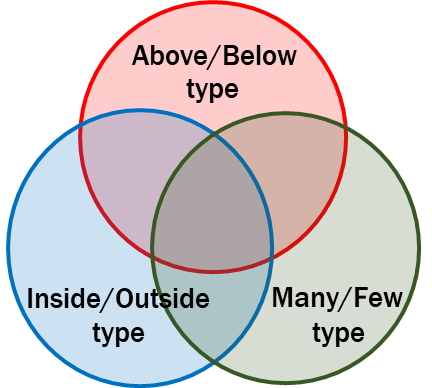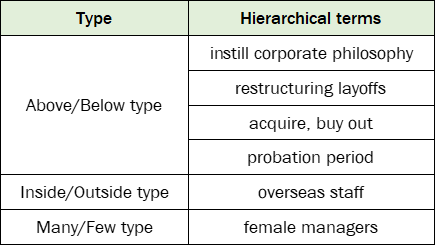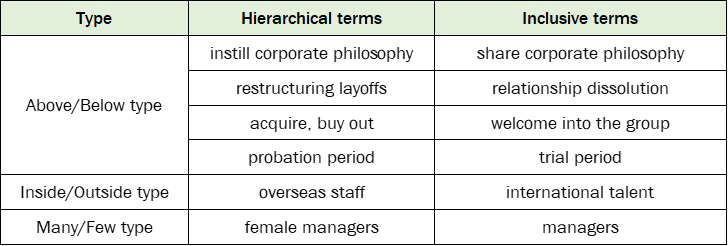Inclusive language refers to a collection of neutral expressions designed not to marginalize any particular group within a diverse society.
In the previous column we looked at inclusive language from the perspectives of sociolinguistics and national culture.
In this column we will continue our exploration of inclusive language by looking for expressions with hierarchical nuances in terminology related to people and organizations. Furthermore, we will approach the expressions we identify from a practical perspective to see how we can convert them to make them more inclusive while presenting examples based on our experience.
How hierarchical terms can be classified
In the process of identifying hierarchical terms related to people and organizations, we realized that they could be broadly grouped into three category types: the “above/below” type, the “inside/outside” type, and the “many/few” type.
Above/below-type terms include nuances suggesting that those in a higher position or who rank higher in the hierarchy dominate those in a lower position or ranking. Such words and phrases are classic examples of hierarchical language.
Terms that fall into the inside/outside-type category imply clear boundaries between “inside” and “outside” groups with a distance separating the two. As the “inside” group is understood to be in the higher position, such terms could be described as conveying nuances similar to those in the above/below-type category.
Many/few-type language distinguishes between majority and minority groups and includes nuances that label those in the minority as anomalies. Because the majority assumes a dominant position over the minority or represents the mainstream, those in the majority could also be viewed as similar in nature to an inside group.

Something that these three types have in common is that they take an exclusionary view of people who are different. In addition, some of the terms include multiple elements with each type comprising overlapping relationships, as shown in the Venn diagram above.
Making hierarchical language inclusive
The table below provides some specific examples of terms related to people and organizations that we feel have hierarchical nuances.

Next, we’ll explain why we considered these terms to be hierarchical and how we went about converting them into other expressions.
<Above/Below type>
Instill corporate philosophy → Share corporate philosophy
Those on the receiving end of this expression could view the verb “instill” as offensive, as if they are simply and unilaterally being subjected to the other party’s way of thinking. By changing it to “share,” it may be possible to more clearly show that the party who wants to convey the philosophy and the party to whom it is being conveyed are on equal footing rather than in a hierarchical relationship.
Restructuring layoffs → Relationship dissolution
When viewed from the perspective of the party being “restructured,” the word “restructuring” could give the impression that they are being treated as objects rather than people. In addition, the word “layoff” has a strong negative image. Therefore, the use of the term “relationship dissolution” could lessen the impression of there being a hierarchical relationship and strengthen the image that both parties are in equal positions.
Acquire/Buy-out → Welcome into the group
The verbs “acquire” and “buy out” strongly evoke a hierarchical relationship between the buying side and side being bought. By changing the expression to “welcome into the group,” we can create the impression of a more balanced relationship in which one side is becoming a member of a group rather than being bought and owned like some kind of object.
In this way, the Rakuten Group is also working to build an inclusive environment by referring to companies that have joined the Group as “group companies” instead of “subsidiaries.”
Probation period → Trial period
The term “probation period” suggests a one-sided hierarchical relationship between the person who is under evaluation and the person or persons doing the evaluating.
When viewed in light of the relationship between employer and employee essentially being more equal in nature, it could be said that the probation period is not only an opportunity for the company to evaluate the new employee, but also an “evaluation period” for the newly hired employee to determine whether or not the company is a good fit.
By changing the word “probation” to “trial,” we can create an expression that conveys the nuance of a period during which both the company and the employee are given opportunities to see if they are a good match for each other.
<Inside/Outside type>
Overseas staff → International talent
In Japan, the use of the word “overseas” tends to draw attention to the distinction between those inside Japan and those outside the country. In addition, the word “staff” doesn’t fully recognize the skills that such people can offer an organization. Therefore, by changing “overseas” to “international” and “staff” to “talent,” we can alleviate the hierarchical above/below nuance as well as the distinction between inside and outside groups.
<Many/Few type>
Female managers → Managers
Since men in managerial positions are not called “male managers,” referring to women in such managerial roles as “female managers” could suggest that such women are anomalies, exceptions to the norm. Therefore, we believe that the “female” label should be removed so that women in such positions are treated the same way as men are and simply referred to as managers.

These are just a few examples that we came up with but we encourage you to try your hand as well along with your colleagues by identifying hierarchical terms and converting them into inclusive ones.
Points to keep in mind when identifying and converting such terms
Through the process of identifying hierarchical terms related to people and organizations and converting them into inclusive alternatives, we feel there are two key points to keep in mind.
The first is to pay close attention and be sensitive to what words or phrases you hear that make you feel as though you belong to a group that is “lower,” “outside,” or “fewer” than others. But that alone is not enough. It’s also necessary to expand your horizons by asking how people who differ from you feel, specifically those who differ in terms of gender, age, position within the company, or lifestyle.
The second is to be open-minded when seeking out inclusive words to replace those used in the original term. For example, in the case of Japanese, alternative wording can sometimes be found by looking to English or other non-Japanese language. The key is to focus on identifying words that are more neutral and inclusive than those used in the original hierarchical term.
Language, by its nature, changes. Such changes are often caused by social conditions. Given that “language reflects society,”* the approach of sociolinguistics is to unravel the origins of language from the perspective of society.
That said, it may be possible to take the opposite approach, one that begins by changing the language we use. Doing so could change the attitudes of people who work in organizations and lead to organizations becoming more inclusive and supportive of well-being.
Reference link:
* Senshu University, School of International Communication, Department of Japanese Language and Linguistics, Sociolinguistics (in Japanese) (Referenced on August 31, 2022)

